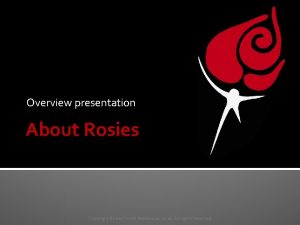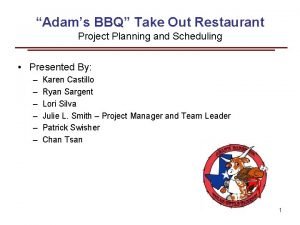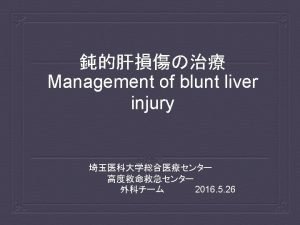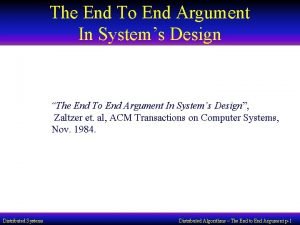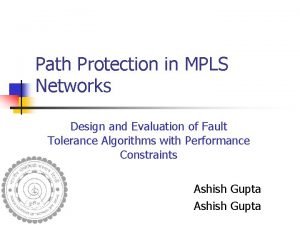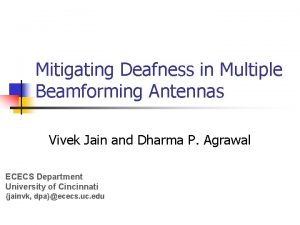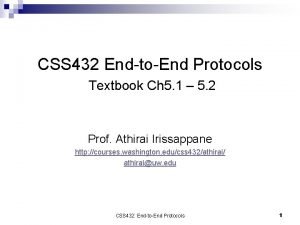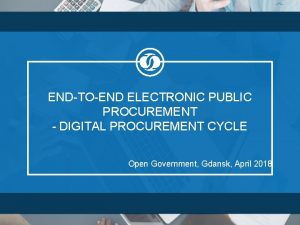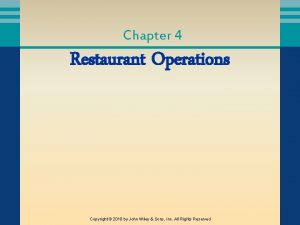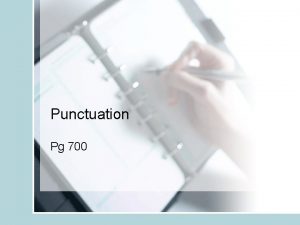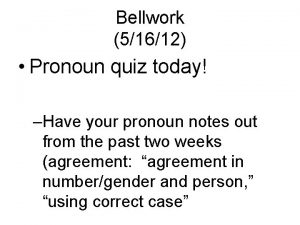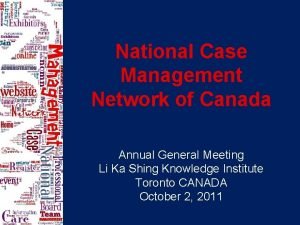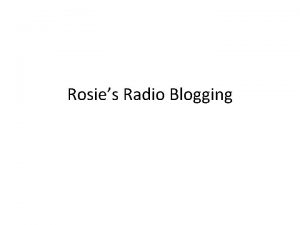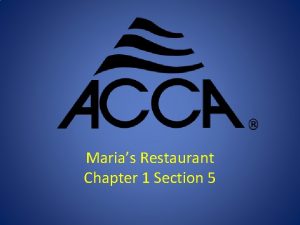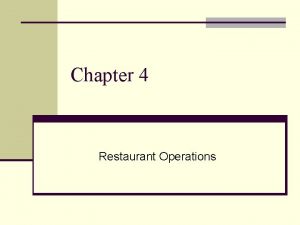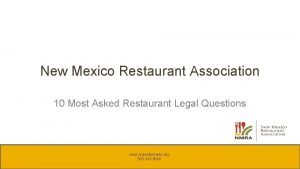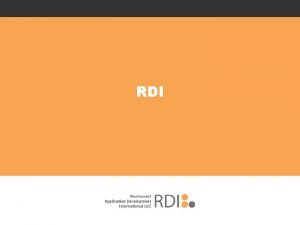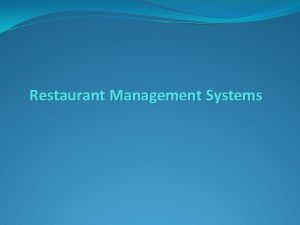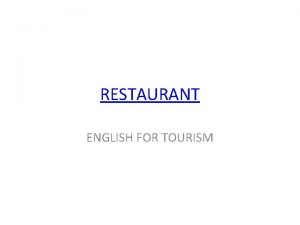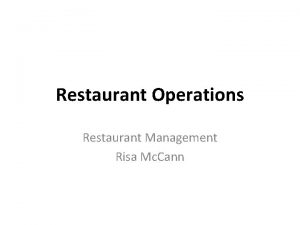Practice Case Rosies East End Restaurant Chapter 6






























- Slides: 30

+ Practice Case Rosie’s East End Restaurant

+ Chapter 6 Audit Responsibilities & Objectives

+ Objective of An Audit - General n To issue an opinion on the financial statements of a company. n For public companies the auditor also issues a report on internal controls over financial reporting (SOX Section 404). n Result of an Audit: n Auditor’s Report

+ Objective of An Audit - Specific n Obtain reasonable assurance about whether the financial statements as a whole are free from material misstatement, whether due to fraud or error, thereby enabling the auditor to express an opinion on whether the financial statements are presented fairly, in all material aspects, in accordance with an applicable financial reporting framework; and n Report on the financial statements, and communicate as required by auditing standards, in accordance with the auditor’s findings.

+ Management’s versus Auditor’s Responsibilities n Management’s Responsibility: n To make sure the financial statements are presented fairly in accordance with GAAP. n Adopting Sound Accounting Policies n Maintaining Adequate Internal Control n Making Fair Representations in the Financial Statements …overall management is responsible for the integrity and fairness of the financial statements. n Auditor’s Responsibility: n To plan and perform an audit sufficient to provide reasonable assurance about whether the financial statements are free of material misstatement, whether caused by errors or fraud and to offer an opinion based on the audit.

+ Management’s versus Auditor’s Responsibilities

+ Reasonable Assurance n Level of certainty that the auditor has obtained at the completion of the audit. n Auditing Standards indicate reasonable assurance is high, but not absolute, level of assurance that the financial statements are free of material misstatement. n The auditor is not an 100% guarantor or insurer of financial statements. n Most audit evidence results from testing a sample. n Financial statements contain complex estimates, which are inherently uncertain. n Fraudulently prepared financial statements are often extremely difficult, if not impossible, for the auditor to detect.

+ Material Misstatements n Misstatement: n Deviation from GAAP in the financial statements caused by error or fraud. n Materiality: n Something large enough or important enough to affect the behavior (decision) of a rational person (on average). n Misstatements are considered material if the combined uncorrected errors and fraud would likely have changed or influenced the decisions of a reasonable person using the financial statements.

+ Auditor’s Responsibility for Fraud n Auditors are responsible for uncovering misstatements due to: n Error – unintentional misstatements n Fraud – intentional misstatements n Misappropriation of assets n Fraudulent financial reporting n Illegal acts – violations of government regulations other than fraud n Violation of federal tax laws n Violation of federal environment protection laws

+ Professional Skepticism – Trust But Verify 1. Questioning Mindset – inquire with some sense of doubt. 2. Suspension of Judgment – withhold judgment until appropriate evidence is obtained. 3. Search for Knowledge – investigate beyond the obvious (desire to corroborate). 4. Interpersonal Understanding – “reading” people. 5. Autonomy – ability to decide for oneself. 6. Self-Esteem – resist persuasion and challenge assumptions.

+ Financial Statement Cycles n Financial Statement Cycles: n Treat every account on the balance sheet as a separate segment. n Keep closely related types (or classes) or transactions and account balances in the same segment. n Sales & Collection Cycle n Usually most important and focus of most audits. n Inventory & Warehousing Cycle n Acquisition & Payment Cycle n Capital Acquisition & Repayment Cycle n Payroll & Personnel Cycle

+ Relationship Among Financial Statement Cycles General cash Capital acquisition and repayment cycle Sales and collection cycle Acquisition and payment cycle Inventory and warehousing cycle Payroll and personnel cycle

+ Management Assertions n Management Assertion: n A fact or truth stated explicitly or implicitly in or through accounting numbers or disclosures in the financial statements. n Evidence: n Anything that supports or refutes a management assertion. or n Anything that causes an auditor to revise his/her belief regarding a management assertion.

+ Management Assertions n Completeness – all transactions, all balance sheet items, and all disclosures are recorded n Existence - assets, liabilities, and equity interests exist n Accuracy - amounts and other data relating to recorded transactions and events have been recorded appropriately n Valuation and allocation - assets, liabilities, and equity interests are included in the financial statements at appropriate amounts, appropriately classified (classification) and in the right period (cutoff) and any resulting valuation or allocation adjustments are appropriately recorded. n Obligations and rights– the company has the rights and obligations of items disclosed n Presentation and disclosure - the components of the financial statements are properly classified, described, and disclosed CEAVOP or C³EAVOP

+ Audit Objectives n Financial Statement Cycles & Audit Objectives: n For any given class of transactions, several audit objectives must be met before the auditor can conclude that the transactions are properly recorded n …and eventually give an unqualified (clean) report. n Transaction-Related Audit Objectives n Balance-Related Audit Objectives n Presentation & Disclosure Audit Objectives n These objectives are closely tied with management’s assertions.

+ Practice Question Management Assertions (what management is representing)

+ Management Assertions n Cash n Accounts Payable n Accounts Receivable n Equipment n Inventory n Notes Payable n Revenue n Goodwill

+ Break 10 Minutes

+ Four Phases of an Audit Phase I • Plan + Design Audit Approach Phase II • Perform Tests of Controls • Perform Substantive Tests of Transactions Phase III • Perform (Substantive) Analytical Procedures • Perform Tests of Details of Balances Phase IV • Complete the Audit and Issue An Audit Report

+ Planning the Audit + Designing an Audit Approach Accept Client & Initial Audit Planning Understand the Business & Industry Perform Prelim Analytics Set Materiality Identify Significant Risks due to Fraud or Error Assess Inherent Risk Understand Internal Control + Assess CR Develop Overall Plan

+ Four Phases of an Audit Phase I • Plan + Design Audit Approach Phase II • Perform Tests of Controls • Perform Substantive Tests of Transactions Phase III • Perform (Substantive) Analytical Procedures • Perform Tests of Details of Balances Phase IV • Complete the Audit and Issue An Audit Report

+ Determining the Planned Audit Approach Audit Evidence from Audit Procedures Evidence from substantive procedures Evidence from tests of operation of controls 22

+ Determining the Planned Audit Approach Audit Evidence Controls (control risk) from Risk. Evidence of Misstatement substantive Au d i t E vi d en ce Inherent Risk of Error procedures Evidence from tests of operation of controls At the assertion level (significant accounts and disclosures) 23

+ Four Phases of an Audit Phase I • Plan + Design Audit Approach Phase II • Perform Tests of Controls • Perform Substantive Tests of Transactions Phase III • Perform (Substantive) Analytical Procedures • Perform Tests of Details of Balances Phase IV • Complete the Audit and Issue An Audit Report

+ Report Results of the Audit n Privately to the Audit Committee n Publicly Through the Audit Report n Types of Reports n Financial Statements are OK – UNQUALIFIED n Financial Statements are mostly OK – QUALIFIED n material misstatement n material scope n Financial Statements are NOT OK – pervasive problems n pervasive misstatement – ADVERSE n pervasive scope - DISCLAIMER

+ Practice Question Phases of the Audit Cycle

+ Phases of the Audit Cycle n For each of the following activities, indicate in which phase of the audit the procedure was likely performed. n Examine invoices supporting recorded fixed asset additions. n Review industry databases to assess the risks in the financial statements. n Summarize misstatements identified to assess whether the overall financial statements are fairly stated. n Test computerized controls over credit approval for sales transactions. n Send letters to customers confirming accounts receivable. n Perform analytical procedures to gain an understanding of the client’s business and strategies. n Compare information on purchase invoices with receiving reports.

+ Practice Case Inventory Count

+ For Tuesday Read Chapter 8 + Knowledge Check Complete Take Home Question (on Own) Skim OVM Case Assignments #1 and #2

+ Take Home Question (due 10/11) Saucedog Bank has a loan of $325, 000 outstanding to Seattle University (SU). SU’s collateral on the loan consists of 25 maintenance trucks with an average original cost of $20, 000. Saucedog is concerned about the collectability of the loan and whether the trucks still exist. Saucedog hires you to count the trucks, using registration information held by the Bank. Saucedog requests that you issue a report stating the following: 1. Which of the 25 trucks is parked in SU’s parking lot on the night of April 30, 2015. 2. Whether all of the trucks are owned by SU. 3. The condition of each truck, along with the fair market value of each truck, using the current “blue book” for each truck. What is the primary assertion (C 3 EAVOP) being tested by each procedure? Pick 1 and only 1 assertion for each procedure and explain how that procedure covers that assertion. Hint – each procedure is a different assertion.
 Rosies mission statement
Rosies mission statement Adams bbq
Adams bbq Best case worst case average case
Best case worst case average case Winds that blow over short distances are called
Winds that blow over short distances are called Kalahari desert on africa map
Kalahari desert on africa map East is east and west is west
East is east and west is west Use case engineering
Use case engineering East practice management guidelines
East practice management guidelines Cardiac output
Cardiac output Edv and preload
Edv and preload Front end of a compiler
Front end of a compiler ------phase is known as the back-end of the compiler.
------phase is known as the back-end of the compiler. Descendorektostomie
Descendorektostomie End-to-end wireframe parsing
End-to-end wireframe parsing End to end argument
End to end argument End to end accounting life cycle tasks
End to end accounting life cycle tasks End to end delay
End to end delay End to end delay
End to end delay End to end
End to end Comet nlp
Comet nlp End-to-end procurement life cycle
End-to-end procurement life cycle Chapter 7 restaurant
Chapter 7 restaurant Chapter 4 restaurant
Chapter 4 restaurant Section b reservation
Section b reservation End mark
End mark Practice assessor and practice supervisor
Practice assessor and practice supervisor Private equity case study presentation
Private equity case study presentation Pronoun case practice
Pronoun case practice Canadian standards of practice for case management
Canadian standards of practice for case management Short case vs long case
Short case vs long case Binary search performance
Binary search performance
